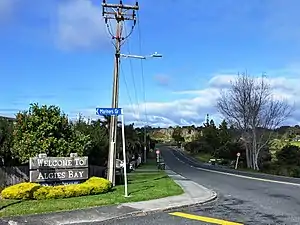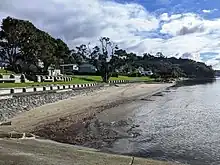Algies Bay | |
|---|---|
 Welcome sign | |
| Coordinates: 36°25′55″S 174°44′17″E / 36.432°S 174.738°E | |
| Country | New Zealand |
| City | Auckland Council |
| Electoral ward | Rodney Ward |
| Local board | Rodney Local Board |
| Area | |
| • Land | 67 ha (166 acres) |
| Population (June 2023)[2] | |
| • Total | 720 |
| Snells Beach | (Kawau Bay) | (Kawau Bay) |
| (Mahurangi Inlet) |
|
(Kawau Bay) |
| (Mahurangi Inlet) | Scotts Landing | Martins Bay |
Algies Bay is a northern coastal suburb of Auckland, in New Zealand. It is on the Mahurangi Peninsula about 68 kilometres (by road) north of the city centre.
Highfield Garden Reserve is an area of public land just north of Algies Bay. Until 1985, it was a privately owned flower-growing and orchard business, which also had donkeys. The owners gifted it to the public, and it now has gardens, walks, fruit trees, and a donkey sanctuary.[3]
Scandrett Regional Park[4] and Mahurangi Regional Park East[5] are south of Algies Bay.
Demographics
The built-up area of Algies Bay covers 0.67 km2 (0.26 sq mi)[1] and had an estimated population of 720 as of June 2023,[2] with a population density of 1,075 people per km2. Algies Bay is part of the larger Algies Bay-Scotts Landing statistical area.
| Year | Pop. | ±% p.a. |
|---|---|---|
| 2006 | 612 | — |
| 2013 | 651 | +0.89% |
| 2018 | 762 | +3.20% |
| Source: [6] | ||

Algies Bay had a population of 762 at the 2018 New Zealand census, an increase of 111 people (17.1%) since the 2013 census, and an increase of 150 people (24.5%) since the 2006 census. There were 318 households, comprising 360 males and 402 females, giving a sex ratio of 0.9 males per female, with 87 people (11.4%) aged under 15 years, 60 (7.9%) aged 15 to 29, 276 (36.2%) aged 30 to 64, and 330 (43.3%) aged 65 or older.
Ethnicities were 92.1% European/Pākehā, 5.1% Māori, 1.6% Pacific peoples, 6.7% Asian, and 1.6% other ethnicities. People may identify with more than one ethnicity.
Although some people chose not to answer the census's question about religious affiliation, 40.9% had no religion, 48.8% were Christian, 0.8% were Hindu and 1.2% had other religions.
Of those at least 15 years old, 132 (19.6%) people had a bachelor's or higher degree, and 144 (21.3%) people had no formal qualifications. 84 people (12.4%) earned over $70,000 compared to 17.2% nationally. The employment status of those at least 15 was that 192 (28.4%) people were employed full-time, 99 (14.7%) were part-time, and 12 (1.8%) were unemployed.[6]
Algies Bay-Scotts Landing statistical area
Algies Bay-Scotts Landing statistical area covers 15.37 km2 (5.93 sq mi)[1] and had an estimated population of 1,230 as of June 2022,[7] with a population density of 80 people per km2.
| Year | Pop. | ±% p.a. |
|---|---|---|
| 2006 | 933 | — |
| 2013 | 1,041 | +1.58% |
| 2018 | 1,185 | +2.63% |
| Source: [8] | ||

Algies Bay-Scotts Landing had a population of 1,185 at the 2018 New Zealand census, an increase of 144 people (13.8%) since the 2013 census, and an increase of 252 people (27.0%) since the 2006 census. There were 498 households, comprising 564 males and 621 females, giving a sex ratio of 0.91 males per female. The median age was 60.2 years (compared with 37.4 years nationally), with 135 people (11.4%) aged under 15 years, 99 (8.4%) aged 15 to 29, 471 (39.7%) aged 30 to 64, and 477 (40.3%) aged 65 or older.
Ethnicities were 93.4% European/Pākehā, 6.3% Māori, 2.0% Pacific peoples, 4.3% Asian, and 1.5% other ethnicities. People may identify with more than one ethnicity.
The percentage of people born overseas was 23.8, compared with 27.1% nationally.
Although some people chose not to answer the census's question about religious affiliation, 45.6% had no religion, 43.3% were Christian, 0.8% were Hindu, 0.8% were Buddhist and 1.0% had other religions.
Of those at least 15 years old, 240 (22.9%) people had a bachelor's or higher degree, and 189 (18.0%) people had no formal qualifications. The median income was $29,500, compared with $31,800 nationally. 159 people (15.1%) earned over $70,000 compared to 17.2% nationally. The employment status of those at least 15 was that 327 (31.1%) people were employed full-time, 168 (16.0%) were part-time, and 24 (2.3%) were unemployed.[8]
Notes
- 1 2 3 "ArcGIS Web Application". statsnz.maps.arcgis.com. Retrieved 26 May 2022.
- 1 2 "Subnational population estimates (RC, SA2), by age and sex, at 30 June 1996-2023 (2023 boundaries)". Statistics New Zealand. Retrieved 25 October 2023. (regional councils); "Subnational population estimates (TA, SA2), by age and sex, at 30 June 1996-2023 (2023 boundaries)". Statistics New Zealand. Retrieved 25 October 2023. (territorial authorities); "Subnational population estimates (urban rural), by age and sex, at 30 June 1996-2023 (2023 boundaries)". Statistics New Zealand. Retrieved 25 October 2023. (urban areas)
- ↑ "Highfield Garden Reserve - Donkeys With A View". Junction. 30 June 2019.
- ↑ "Scandrett Regional Park". Auckland Council. Retrieved 25 May 2020.
- ↑ "Sadler Point, Mahurangi Regional Park (East)". Auckland Council. Retrieved 25 May 2020.
- 1 2 "Statistical area 1 dataset for 2018 Census". Statistics New Zealand. March 2020. 7001346–7001349.
- ↑ "Population estimate tables - NZ.Stat". Statistics New Zealand. Retrieved 25 October 2022.
- 1 2 "Statistical area 1 dataset for 2018 Census". Statistics New Zealand. March 2020. Algies Bay-Scotts Landing (111900). 2018 Census place summary: Algies Bay-Scotts Landing